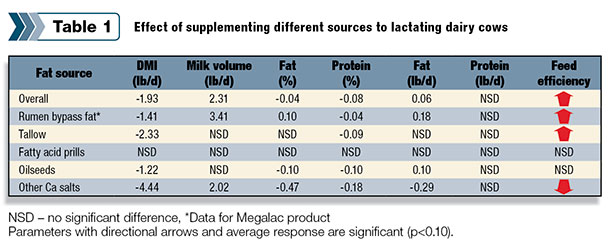Dairy producers seeking to increase the ration energy level for high-producing cows have increasingly turned to feeding supplemental fat as a way to accomplish this goal. That’s because supplemental fat, especially in early lactation, supports milk production, helps cows retain body condition and positively influences reproductive performance. Plus, fats contain 2.25 times more energy than starches and digestible fiber found in common grain or forage sources.
Add in the fact that ration ingredients high in fat content are economical and more available than ever, and it’s easy to understand why supplemental fat feeding has become a common practice.
The challenge is: Many dairy producers think they are getting the same value from different fat sources, but that’s not necessarily the case.
Data diving
If you take a look at the available research, you can clearly see that fats aren’t just fats. The differences in response to various supplemental fat sources are more profound than almost any other nutritional intervention studied to date.
For example, a meta-analysis published in the June 2012 Journal of Dairy Science and illustrated in Table 1 shows how different fat sources affect important milk production parameters.

Note that in this table of meta-analysis results, fat sources and parameters with no significant differences (NSD) reported does not mean there was no effect; it means either the number of published studies for a treatment was low or the effects were variable enough between or within experiments that the direction and magnitude of the effect was not predictable.
However, it should also be noted that differences between the highest and lowest results were often greater than eight standard deviations.
We’ve learned over the years that differences in production response among various fat sources are due to different true energetic content, and that different fat sources are made up of different fatty acids. We also know that different mixes of fatty acids have profoundly different biological effects on animals outside of their energetic effects.
Additionally, recent studies offer more evidence of this premise.
Side-by-side comparisons
A recent study conducted at the University of Delaware and presented at the 2013 American Dairy Science Annual Meeting evaluated the long-term effects of two different supplemental dietary fat sources on early lactation milk production.
The study found the following:
- Over the course of the 12-week trial, cows fed calcium salts of palm fatty acids produced significantly more pounds of milk, milk fat and protein than the fatty acid prill. The cows fed calcium salts of palm fatty acid also exhibited more persistency of lactation as well.
- As a result, cows in this group had improved feed efficiency and income over feed cost.
In addition, the study results also indicate that short-term feeding trials or demonstrations are insufficient to evaluate various sources of supplemental fatty acids.
Therefore, the researchers concluded that supplemental fatty acids have differential effects on milk production and persistency of production. Also, there is reason to believe, based on this study, there is a maximum amount of certain fat sources, like fatty acid prills, that can be effectively utilized in milk and component synthesis.
Subsequent research conducted at Washington State University, which will be presented at the 2014 American Dairy Science Annual Meeting this summer, found milk production and milk fat production were similar for the two supplemental dietary fat sources.
These results suggest that cows at different stages of lactation use individual fatty acids differently due to metabolic status. This knowledge opens the way for ration formulation with supplemental fats to be more effective in the future.
Choose wisely
Meanwhile, there are a few more considerations to keep in mind when selecting a source of supplemental fat.
First and foremost, it is important to use products that feature published research and are from reputable sources.
According to Dr. Thomas Jenkins, Clemson University animal science professor emeritus, who has conducted numerous nutrition research trials, “Use caution when obtaining fats from unknown vendors to be sure that considerable impurities do not still remain in the product that lower the fatty acid and energy content.”
Also know that rendered or processed fats originate primarily as recovered waste fats and can be highly variable in quality, so be sure to choose a consistent, reliable, proven fat source.
Last, while feeding supplemental fat may have a downward impact on dry matter intake, this tool has a strong positive influence on milk volume and milk fat yield, which increases feed efficiency. Be sure you are evaluating feed ingredients on the totality of their impact, not just one aspect, and have a plan to monitor animal performance to ensure you have chosen wisely. PD
References omitted due to space but are available upon request. Click here to email an editor.

Elliot Block
Senior Manager of Technology
Arm & Hammer Animal Nutrition







